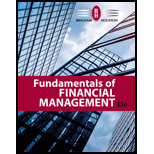
a.
To discuss: The
Introduction:
Stock is a type of security in a company that denotes ownership. The company can raise the capital by issuing stocks.
a.
Explanation of Solution
The preferred stock differs from debt and common equity is as follows:
Preferred stock can be termed as hybrid stock because it is similar characteristically with common equity and debt. The preferred payments made to the investors remain contractually stable resembling debt whereas like common equity the non-payment of dividend does amount to default and bankruptcy.
Even most preferred stock prohibits paying common dividends when there are arrears in preferred. Moreover, their dividends are cumulative until a level. The dividend on common stock is not paid just in case of non-payment of dividend on preferred stock.
b.
To discuss: The meaning of adjustable-rate preferred.
b.
Explanation of Solution
The meaning of adjustable-rate preferred is as follows:
A particular form of preferred stock wherein the dividends issued varies with a benchmark such as Treasury-bill rate is termed as adjustable-rate preferred. This is the best short-term corporate investment since only 30 percent of the dividends are taxable to corporations and even the floating rate keeps the issue trading at the par value. Moreover, the adjustable-rate preferred stock will have price instability mostly for the liquid portfolios of numerous corporate investors.
c.
To discuss: The knowledge of call options helps people to understand convertibles and warrants.
Introduction:
Option is a contract to purchase a financial asset from one party and sell it to another party on an agreed price for a future date. There are two types of options, which are as follows:
- An option that buys an asset called call option
- An option that sells an asset called put option
c.
Explanation of Solution
The knowledge of call options helps people to understand convertibles and warrants is as follows:
Both the convertibles and warrants are two forms of call options. The understanding of options will help a company’s financial managers to make decision on convertible and warrant issues.
d.1.
To determine: The coupon rate that is set on the bond with warrants.
Introduction:
A warrant is securities that give the bondholder the right, yet not the obligation, to purchase a specific number of securities at a specific cost before a particular period.
d.1.
Explanation of Solution
Given information:
Person M (
The formula to compute the value of package is as follows:
Compute the value of warrant:
Note: Assume the entire package is to sell for the price of $1,000.
Hence, the value of warrant is $75.
Compute the
Hence, the value of bond is $925.
Compute the PTM
The table below shows the Excel formula to compute the PTM:

The table below shows the calculated value of PTM:

Hence, the PTM is $109.96. The bonds will have a value of $925 and the package of one bond plus 50 warrants will cost $1,000 at 12 percent coupon rate.
d.2.
To discuss: The implication of terms of issues and whether the company loses or wins.
d.2.
Explanation of Solution
The implication of terms of issues and determine whether the company loses or wins are as follows:
The company issues bonds and warrants directly trade for $2.50 each for 50 warrants. The total worth of 50 warrants will be $125
d.3.
To discuss: The expected period when the warrants to be exercised.
d.3.
Explanation of Solution
The expected time when the warrant to be exercised is discussed below:
A warrant is sold for premium beyond exercise value in an open market. Every investor will sell warrants in specific place than exercising it; on stock selling at price more than exercise price. However, few warrants comprise of step-up provisions of exercise price in which exercise price raises than warrant’s life period. It is because the warrant value drops when the exercise price increases.
As a result, the step-up provision will support holders for exercising their warrants. Therefore, the warrants holder would voluntarily exercise when there is higher dividend. Moreover, the higher dividends will raise the attraction of stock from warrants.
d.4.
To discuss: Whether the warrants will bring in additional capital when exercised and determine the type of capital.
d.4.
Explanation of Solution
Determine whether the warrants will bring in additional capital when exercised and determine the types of capital are as follows:
At the time when a warrant is exercised, it will bring in exercise price or additional capital of $12.50 (equity capital). As a result, the holder will receive a share of common stock per warrant. Here, let assume that the exercise price is set at 10 percent to 30 percent above the current price of stock. In this case, a higher-growth company will set the exercise price to a higher-end range and vice-versa.
d.5.
To discuss: Whether all the debt been issued with warrants when the warrants lower the cost of debt and determine the expected cost of the bond with warrants.
d.5.
Explanation of Solution
Determine whether all the debt been issued with warrants when the warrants lower the cost of debt and determine the expected cost of the bond with warrants are as follows:
The overall cost of the issue will be higher than straight debt even though the coupon rate on the debt is lower. Few returns are contractual in nature for the investors while the remaining return is related to price of stock movements. As a result, the cost will be much higher as compared to the debt. Therefore, the overall cost and risk is greater as compared to the cost of debt.
At the time when the warrants are exercised in 5-years, then the price of stock will be $17.50. Then the F Company will exchange stock worth $17.50 for one warrant plus $12.50. Therefore, the company will realize an
To discuss: The comparison on the cost of bond with warrants by the cost of straight debt and cost of common stock.
Explanation of Solution
Given information:
Person M (financial manager) of the F Company decided to issue a bond with warrants. The current stock price of the company is $10 and cost of 20-years annual coupon debt is 12 percent without warrants. Later, the banker has recommends to assign 50 warrants for every bond of the company. The exercise price of the warrant is $12.50 and the value of every warrant when detached and trade separately is $1.50.
Note: The F Company will make interest payments over the 20-year life of bonds and repay the principal after 20-years.
Compute the
The table below shows the Excel formula to compute the IRR:
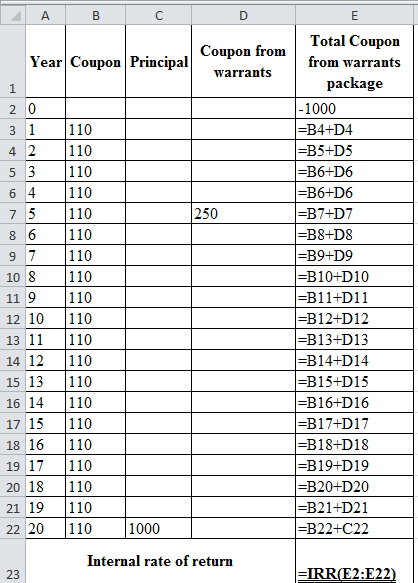
The table below shows the calculated value of IRR:
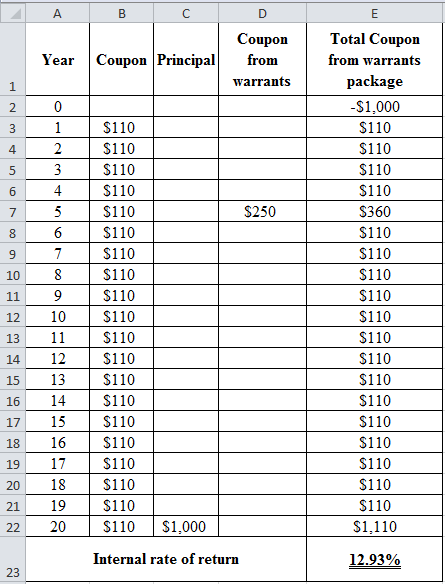
Hence, the IRR is 12.93%. The IRR from this cash flows stream is higher than the 12 percent cost of straight debt. It is because the issue is riskier as compared to the straight debt as per the investor point of view. However, the bonds with warrants will be less risky as compared to the common stock. Therefore, the bonds with warrants will have a lower cost than common stock.
e.1.
To determine: The conversion price and whether ot is implied in the convertible’s terms.
e.1.
Explanation of Solution
Given information:
Person M is considering convertible bonds. As per the investment banker estimates, the F Company will sell a 20-years bond for 10 percent coupon rate. The callable convertible bond’s face value is $1,000 and straight-debt issue will need a 12% coupon rate. The F Company’s current price of stock is $10 and its last year’s dividends are $0.74. The constant growth rate of dividend is 8 percent and it’s converted in 80 shares of F Company’s stock at the position of owner.
The formula to compute the conversion price is as follows:
Compute the conversion price:
Hence, the conversion price is $12.50. Here, the conversion price can be assumed as the convertible’s exercise price, even though it has already paid out. Therefore, the conversion price is set at 20 percent to 30 percent above the prevailing stock price as with the warrants.
e.2.
To determine: The straight-debt value of the convertible and implied value of the convertibility.
e.2.
Explanation of Solution
Given information:
Person M is considering convertible bonds. As per the investment banker estimates, the F Company will sell a 20-years bond for 10 percent coupon rate. The callable convertible bond’s face value is $1,000 and straight-debt issue will need a 12% coupon rate. The F Company’s current price of stock is $10 and its last year’s dividends are $0.74. The constant growth rate of dividend is 8 percent and it’s converted in 80 shares of F Company’s stock at the position of owner.
The formula to compute the value of convertibility is as follows:
The formula to compute per share value of convertibility is as follows:
Compute the value of 10% annual coupon bonds (straight bond):
The table below shows the Excel formula to compute the value of 10% annual coupon bonds:
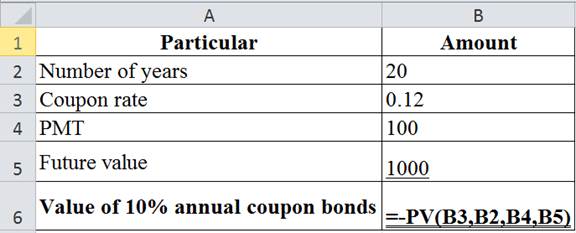
The table below shows the calculated value of 10% annual coupon bonds:
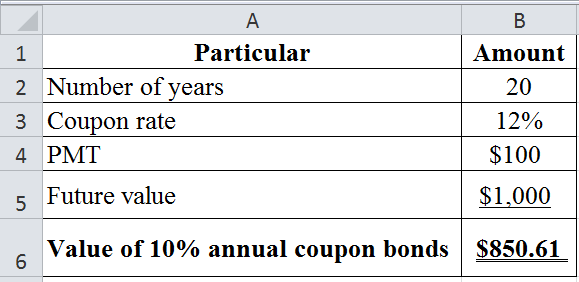
Hence, the value of 10% annual coupon bonds is $850.61.
Compute the value of convertibility:
Note: The convertible will sell at $1,000 (face value).
Hence, the value of convertibility is $149.39.
Compute the per share value of convertibility:
Hence, per share value of convertibility is $1.87.
e.3.
To determine: The formula for the conversion value of bond in any year and even compute the value of conversion at Year 0 and Year 10.
e.3.
Explanation of Solution
The formula for the conversion value of bond in any year is as follows:
The value of the stock which is obtained by converting is termed as conversion value in any year. In the case of F Company, the stock price is expected to increase by “g” every year since it has a constant growth stock. Therefore, the formula for the conversion value of bond in any year is given below:
Where,
Pt refers to the price at conversion of bonds
Po refers to the current stock price
g refers to the constant growth rate of stock
t refers to the number of years
Note: The value of converting at any year is denoted as CR(Pt). Here, CR refers to the number of share received.
Compute the value of conversion at Year 0:
Hence, the value of conversion at Year 0 is $800.
Compute the value of conversion at Year 10:
Hence, the value of conversion at Year 10 is $1,727.12.
e.4.
To discuss: The meaning of the term floor value of a convertible and compute the convertible’s expected floor value in the Year 0 and Year 10.
e.4.
Explanation of Solution
The meaning of term floor value of a convertible and even compute the convertible’s expected floor value in the Year 0 and Year 10 are as follows:
The higher of straight-debt value and higher value of conversion is termed as floor value of a convertible.
Compute the expected floor value of convertible in the Year 0:
The table below shows the Excel formula to compute the value of 10% annual coupon bonds:
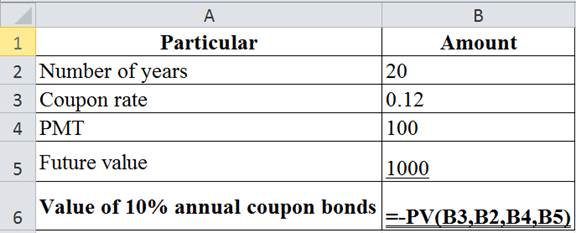
The table below shows the calculated value of 10% annual coupon bonds:

Hence, the value of 10% annual coupon bonds is $850.61. The straight-debt value in Year 0 is $850.61 when the conversion value is $800. Therefore, the floor value is $850.61.
The conversion value of $1,727.12 is higher than the straight-debt value at the Year 10. Therefore, the conversion value sets at the floor price. The convertible would sell above its floor value in any period before the date of maturity. It is because the convertibility option carries extra values.
e.5.
To determine: The number of year or period when the issue is expected to callable.
e.5.
Explanation of Solution
Given information:
Person M is considering convertible bonds. As per the investment banker estimates, the F Company will sell a 20-years bond for 10 percent coupon rate. The callable convertible bond’s face value is $1,000 and straight-debt issue will need a 12% coupon rate. The F Company’s current price of stock is $10 and its last year’s dividends are $0.74. The constant growth rate of dividend is 8 percent and it’s converted in 80 shares of F Company’s stock at the position of owner.
The formula for the conversion value of bond in any year is given below:
Where,
Pt refers to the price at conversion of bonds
Po refers to the current stock price
g refers to the constant growth rate of stock
t refers to the number of years
Compute the number of years or period when the issue is expected to callable:
Hence, the number of year is 5.2678 years that is considered as 5-years.
e.6.
To determine: The expected cost of the convertible and whether the cost appears consistent with the risk of the issue.
e.6.
Explanation of Solution
Given information:
Person M is considering convertible bonds. As per the investment banker estimates, the F Company will sell a 20-years bond for 10 percent coupon rate. The callable convertible bond’s face value is $1,000 and straight-debt issue will need a 12% coupon rate. The F Company’s current price of stock is $10 and its last year’s dividends are $0.74. The constant growth rate of dividend is 8 percent and it’s converted in 80 shares of F Company’s stock at the position of owner. The conversion value in Year 5 is $1,200.
Compute the IRR:
The table below shows the Excel formula to compute the IRR:
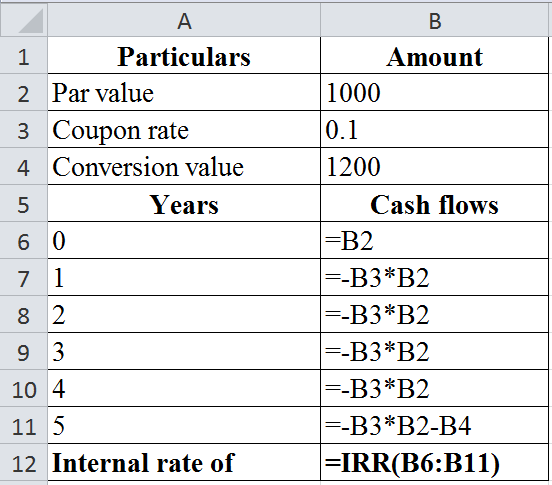
The table below shows the calculated value of IRR:
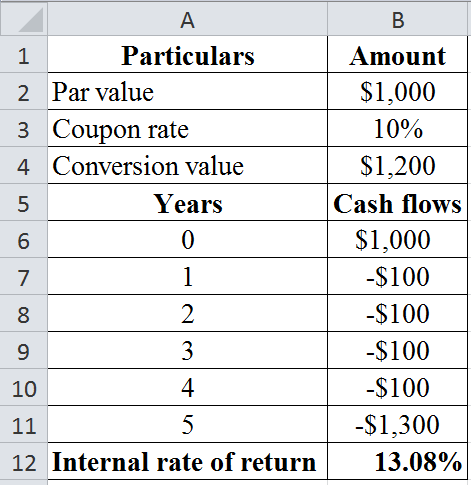
Hence, the IRR is 13.08% that is the cost of the convertible issue.
Compute the
Hence, the cost of equity is 0.15992 that is approximately is 16%. The convertible bond of firm has risk, which falls between the risk of its equity and debt. Therefore, the cost that appears consistent with the risk of the issue is 13.08 percent.
f.
To discuss: The factors that Person M as to consider on making decision between to securities.
f.
Explanation of Solution
The factors that Person M as to consider on making decision between to securities are as follows:
- The Person M has to consider the future need for capital of the company. The warrants must be favorable because their exercise can bring in extra equity capital without retirement of the low-cost debt when the company anticipates continues need for capital. On the contrary, the convertible issue cannot bring in new funds at conversion.
- The second factor that Person M must consider is whether the Company wants to commit towards 20-year of debt at this period. Here, the conversion can remove off the debt issue but it does not occur on the exercise of warrants. In case, the F Company cannot increase over the period, then neither the warrants nor the convertibles will be exercised and debt will remain outstanding in the both case.
Want to see more full solutions like this?
Chapter 20 Solutions
Bundle: Fundamentals Of Financial Management, 15th + Mindtap Finance, 2 Terms (12 Months) Printed Access Card
- Can you solve these questions on a financial calculator: $5,000 received each year for five years on the last day of each year if your investments pay 6 percent compounded annually. $5,000 received each quarter for five years on the last day of each quarter if your investments pay 6 percent compounded quarterly.arrow_forwardNow suppose Elijah offers a discount on subsequent rooms for each house, such that he charges $40 for his frist room, $35 for his second, and $25 for each room thereafter. Assume 30% of his clients have only one room cleaned, 25% have two rooms cleaned, 30% have three rooms cleaned, and the remaining 15% have four rooms cleaned. How many houses will he have to clean before breaking even? If taxes are 25% of profits, how many rooms will he have to clean before making $15,000 profit? Answer the question by making a CVP worksheet similar to the depreciation sheets. Make sure it works well, uses cell references and functions/formulas when appropriate, and looks nice.arrow_forward1. Answer the following and cite references. • what is the whole overview of Green Markets (Regional or Sectoral Stock Markets)? • what is the green energy equities, green bonds, and green financing and how is this related in Green Markets (Regional or Sectoral Stock Markets)? Give a detailed explanation of each of them.arrow_forward
- Could you help explain “How an exploratory case study could be goodness of work that is pleasing to the Lord?”arrow_forwardWhat are the case study types and could you help explain and make an applicable example.What are the 4 primary case study designs/structures (formats)?arrow_forwardThe Fortune Company is considering a new investment. Financial projections for the investment are tabulated below. The corporate tax rate is 24 percent. Assume all sales revenue is received in cash, all operating costs and income taxes are paid in cash, and all cash flows occur at the end of the year. All net working capital is recovered at the end of the project. Year 0 Year 1 Year 2 Year 3 Year 4 Investment $ 28,000 Sales revenue $ 14,500 $ 15,000 $ 15,500 $ 12,500 Operating costs 3,100 3,200 3,300 2,500 Depreciation 7,000 7,000 7,000 7,000 Net working capital spending 340 390 440 340 ?arrow_forward
- What are the six types of alternative case study compositional structures (formats)used for research purposes, such as: 1. Linear-Analytical, 2. Comparative, 3. Chronological, 4. Theory Building, 5. Suspense and 6. Unsequenced. Please explainarrow_forwardFor an operating lease, substantially all the risks and rewards of ownership remain with the _________. QuestFor an operating lease, substantially all the risks and rewards of ownership remain with the _________: A) Tenant b) Lessee lessor none of the above tenant lessee lessor none of the aboveLeasing allows the _________ to acquire the use of a needed asset without having to make the large up-front payment that purchase agreements require Question 4 options: lessor lessee landlord none of the abovearrow_forwardHow has AirBnb negatively affected the US and global economy? How has Airbnb negatively affected the real estate market? How has Airbnb negatively affected homeowners and renters market? What happened to Airbnb in the Tax Dispute in Italy?arrow_forward
- How has AirBnb positively affected the US and global economy? How has Airbnb positively affected the real estate market? How has Airbnb positively affected homeowners and renters market?arrow_forwardD. (1) Consider the following cash inflows of a financial product. Given that the market interest rate is 12%, what price would you pay for these cash flows? Year 0 1 2 3 4 Cash Flow 160 170 180 230arrow_forwardExplain why financial institutions generally engage in foreign exchange tradingactivities. Provide specific purposes or motivations behind such activities.arrow_forward
 Intermediate Financial Management (MindTap Course...FinanceISBN:9781337395083Author:Eugene F. Brigham, Phillip R. DavesPublisher:Cengage Learning
Intermediate Financial Management (MindTap Course...FinanceISBN:9781337395083Author:Eugene F. Brigham, Phillip R. DavesPublisher:Cengage Learning
 Financial Reporting, Financial Statement Analysis...FinanceISBN:9781285190907Author:James M. Wahlen, Stephen P. Baginski, Mark BradshawPublisher:Cengage Learning
Financial Reporting, Financial Statement Analysis...FinanceISBN:9781285190907Author:James M. Wahlen, Stephen P. Baginski, Mark BradshawPublisher:Cengage Learning



